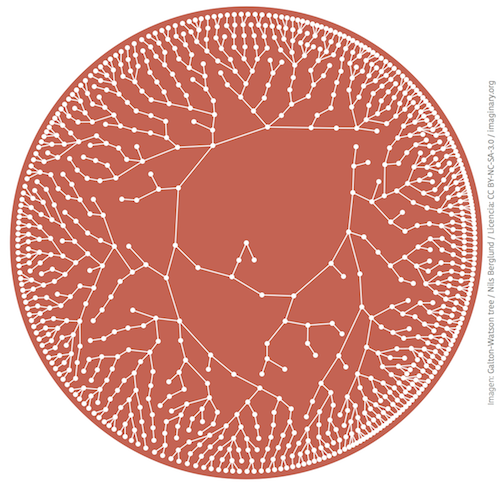Cursos
Branching process and genealogies
Prof. Vincent Bansaye
This course will deal with Galton Watson branching process, the genealogical structure of the underlying tree and the mutlitype case. First we will introduce the Galton Watson process and focus on the extinction probability. We may give two approaches : the use of generating functions and the Lamperti transform. Second, we are considering the genealogical structure of the population of tree describing the genealogy and build a spine construction due to Lyons, Pemantle and Peres. We shall use this techniques to characterize the growth of the process when it survives. Third, we will take into account different types of individuals and extend the previous construction of trees. In particular, we could characterize the law of the ancestral lineage of a sampled individual at a given time. Finally we may explain how such approaches extend to the infinite dimensional case and varying environment. Alternatively, we could take into account environment stochasticity and consider the random environment framework, where new phenomena appear.
Spanning trees
Prof. Loïc Chaumont
Kirchhoff’s matrix tree theorem is a combinatorial formula giving the number of spanning trees in a finite graph. These lectures aim at proving this result and pre- senting some important applications in probability theory and combinatorics. One of the most famous of these applications that we will present here is an expression for the invariant distribution of irreducible finite state Markov chains. Direct appli- cations of the matrix tree theorem also allow us to give the number of rooted trees and forests which can be obtained from a given set of labeled vertices. Those are the Cayley formulas. Then we will treat the case of multigraphs and multitype trees and forests. Kirchhoff’s matrix tree theorem also provides a useful tool for the proof of the multivariate Lagrange inversion formula. In the last part of these lectures, we will see that this theorem is closely related to the expression of the law of the total progeny of multitype branching forests.
Transporte óptimo y aplicaciones a economía, estadística e investigación de operaciones
Prof. José Blanchet
In these series of lectures we will review recent results at the intersection of optimal transport, stochastic OR and statistics. After reviewing basic notions of optimal transport costs and Wasserstein distances, we will discuss distributionally robust performance analysis and optimization results. For example, we will show how the theory of diffusion approximations can be harnessed in this setting to provide model-robust sample path estimates for general stochastic systems. In addition, using the same mathematical principles, we will show that many machine learning algorithms such as sqrt-Lasso, regularized logistic regression, group Lasso, adaptive Lasso, support vector machines, among many others admit distributionally robust representations based on optimal transport costs. Additional connections to artificial intelligence via generative networks will also be discussed. Finally, we also introduce model statistical methodology which can be used to optimally choose the uncertainty size in distributionally robust formulations.





